Last Updated on 2025-07-30
How essential is your software RFP?
It plays a significant role in attracting the right business partners for your software development project.
Here are our top tips on creating a detailed software RFP to ensure you get the best experts for the job.
Navigating the Software Development RFP Process Successfully
Creating a Request for Proposal (RFP) for software development is critical in finding the right vendor and ensuring a successful project.
A well-written software RFP serves as a formal invitation to potential suppliers. It outlines your project’s parameters and invites the ideal vendors to submit a proposal addressing your needs.
Understanding RFPs within the IT Procurement Landscape
Software RFPs are a blueprint for delineating project scope and guiding vendors through procurement. It outlines requirements and expectations, from software functionality to infrastructure prerequisites.
If leveraged correctly, software RFPs increase your likelihood of finding the right contractor. The software RFP can help you assess submissions thoroughly, ensuring accuracy and alignment with the project’s objectives.
It’s an excellent tool to attract and manage transactions with the best partners.
Shortlisting Vendor Using RFP
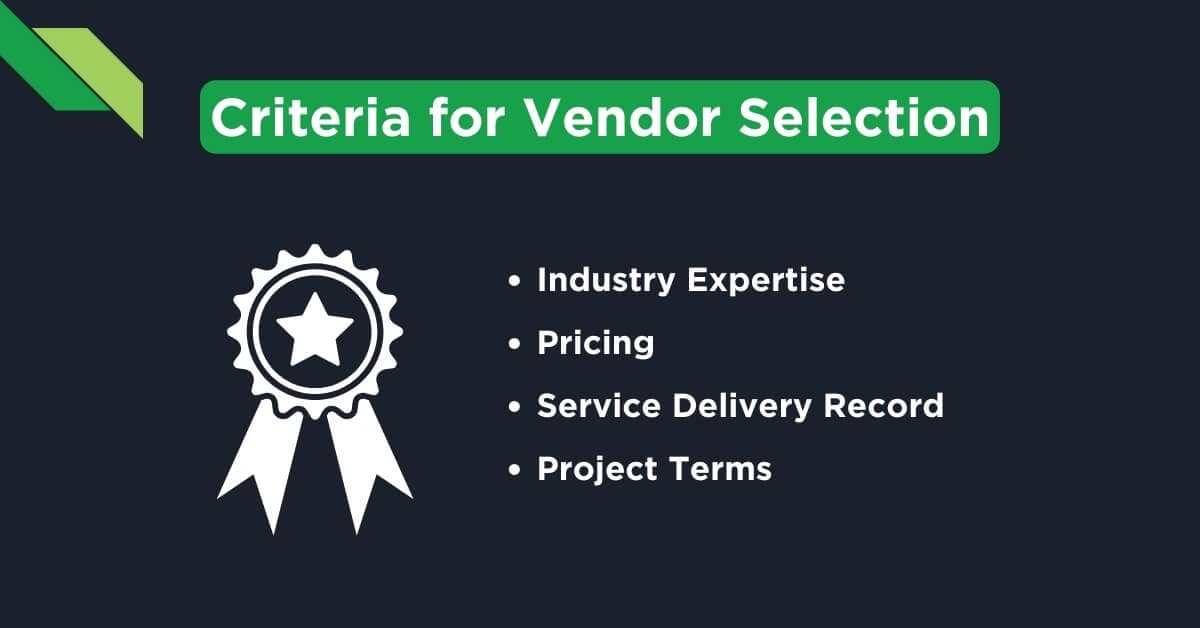
One pivotal aspect of navigating software RFPs is the process of shortlisting vendors.
This entails a meticulous breakdown of submissions, evaluating them against predefined criteria, and scrutinizing documentation for compliance and completeness.
The goal is to shortlist proposals that best align with the project’s objectives and requirements. Organizations streamline the procurement process by shortlisting, focusing on engaging with vendors most likely to deliver desired outcomes.
However, achieving an accurate shortlist requires more than just ticking boxes. A nuanced understanding of the project’s intricacies and the capabilities of potential vendors is needed.
The right partner must possess the technical expertise and the adaptability to meet evolving needs throughout the project lifecycle.
The Anatomy of an Effective Software RFP
So, what makes up a software RFP? Let’s discuss the essential details that should be included in your proposal.
Essential Components of a Software RFP
A good software RFP includes several critical sections that form the bedrock of a comprehensive and informative request. Each component plays a specific role in painting a complete picture of your needs.
Here’s what should be included:
- Executive Summary: Begin with an overview of your project and the business problems you are trying to solve. This section should be succinct, setting the stage for the detailed information that follows.
- Background Information: Offer context by providing corporate information, project background, and existing issues or pain points. This helps vendors understand the environment in which their solution must operate.
- Scope of Work (SOW): Clearly outline the scope, including the specific services, deliverables, and functionality required. This section is critical as it defines the boundaries and deliverables of the project.
- Requirements: Detail the functional, technical, and user requirements. Be as explicit as possible — ambiguity can result in responses that do not fully address your needs.
- Timeline: Specify the expected project timeline, including milestones and deadlines. This helps vendors assess their ability to meet your schedule before submitting a proposal.
- Budget: If possible, provide a budget range. This ensures you receive realistic proposals that align with your financial expectations.
- Vendor Qualifications and References: State the criteria for the vendor’s experience, skills, and past performance. Asking for references or case studies can provide insight into their track record of success.
- Proposal Submission Guidelines: Lay out the proposal submission process, including the format, deadline, and designated point of contact. This simplifies the vendor submission process and streamlines the review process on your end.
- Evaluation Criteria: Define how you will evaluate proposals, including technical, financial, and strategic dimensions. Vendors should understand how their responses will be measured.
- Terms and Conditions: Include the legal and procedural terms under which the project will be conducted, including payment terms, confidentiality requirements, and contract termination conditions.
Your software RFP should provide the complete details about the project.
It should include methodologies like Scrum or Kanban. It can be presented in easy PDF form containing a spreadsheet of various items.
When sharing the document, you may need to convert PDF files to other formats for easier collaboration or editing.
These are some of the items you can discuss in full detail in the software RFP:
- Budget
- Project calendar
- Prototype
- Pricing structure
By incorporating these components into your software RFP, you’ll have a document that serves as a request for solutions. It’s a helpful tool for your procurement team to evaluate all available consulting services from prospective vendors.
Templates and Tools to Streamline Your RFP Creation
There are many RFP proposal templates available in the market today.
Some of the most popular proposal software are PandaDoc, Bidsketch, and Nusii. Depending on your company size and project needs, you can browse a long list of available tools and templates for your RFP.
Efficiency and coherence in RFP creation can be significantly enhanced by utilizing templates and tools designed for this purpose. PandaDoc’s RFP builder is one such tool that can help transform this often arduous process.
Here’s how:
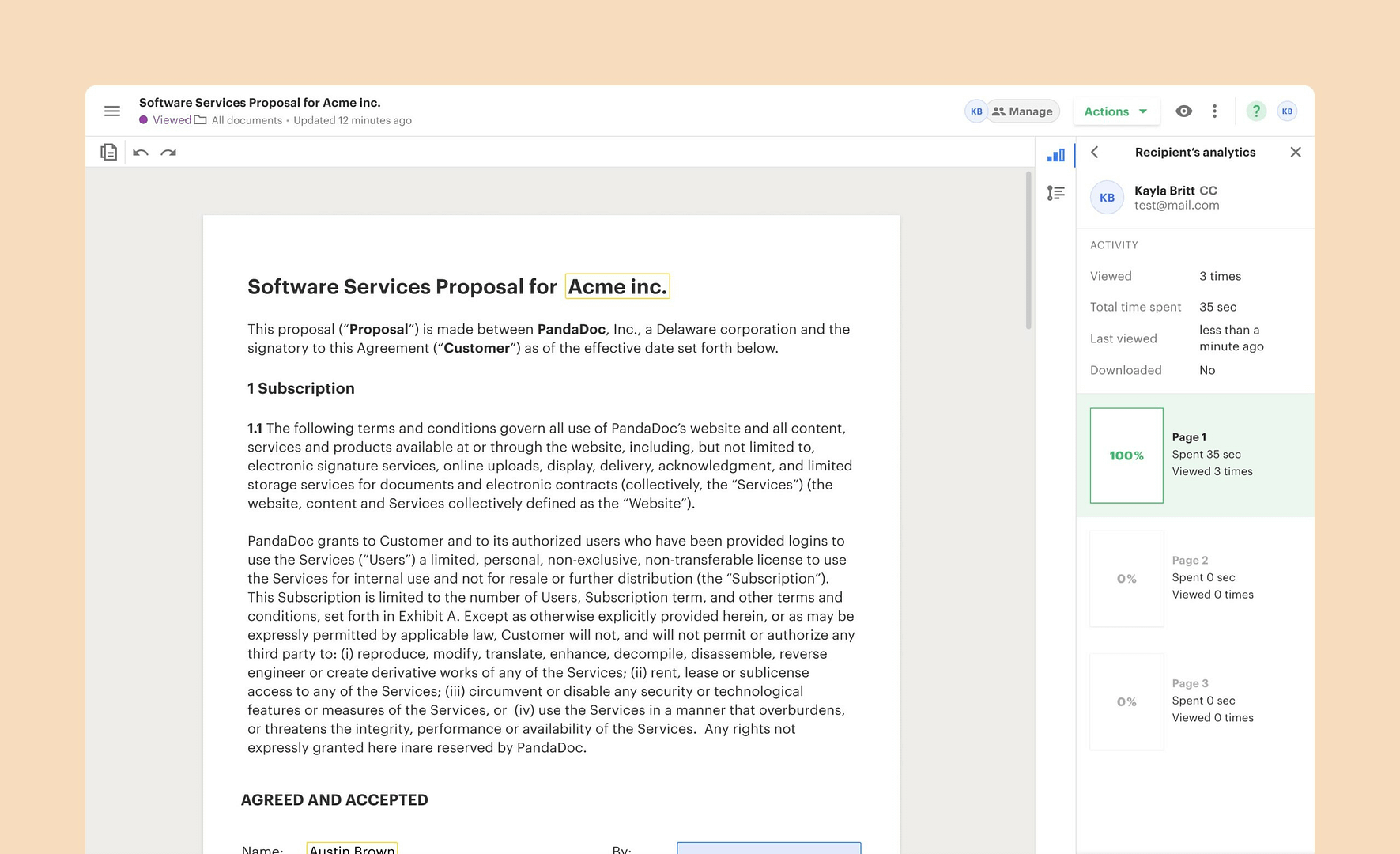
- Ready-to-Use Templates: PandaDoc offers a wide range of customizable templates suitable for various industries and project types, providing a solid foundation that aligns with your brand and project requirements, including template ideas.
- Customizable Content Blocks: These templates include customizable sections, allowing you to tailor the RFP to your specific project needs while maintaining a consistent format and brand identity, including a company overview.
- Collaborative Editing: PandaDoc enables real-time collaboration, allowing multiple team members to contribute, offer feedback, and edit the RFP simultaneously. This collaborative approach enhances the comprehensiveness of proposals, leveraging Kanban methodologies for efficient workflow management.
- Integration with eSignatures: The platform integrates eSignature capabilities, enabling seamless document signing and reducing the time-to-close. This streamlines the proposal process and enhances efficiency while reducing administrative overhead, including automation features.
- Accessibility and Sharing: Cloud-based tools ensure accessibility of RFP documents from anywhere, while template-sharing capabilities promote team-wide coherence. Every team member works with the latest, approved version of the document, and download options are available for offline access.
- Document Management: PandaDoc provides robust document management systems to keep track of all RFPs in one place, facilitating easy retrieval for reference or auditing purposes. This includes Loopio integration for streamlined RFP documentation management.
- Quality Assurance: PandaDoc ensures quality assurance with customizable content blocks and collaborative editing features, ensuring accuracy and consistency throughout the RFP process.
- Reminder and Checklist: Built-in reminder and checklist features help keep the RFP process on track, ensuring deadlines are met and all necessary steps are completed.
- Contact Email and Email: Integration with email allows for seamless communication with stakeholders, while contact email fields ensure clarity on points of contact within the document.
- Prototype and Pricing Structure: Templates and content blocks enable the creation of prototypes and detailed pricing structures within the RFP, providing a comprehensive overview of the project requirements and costs.
- Ebook and RFP Presentations: PandaDoc offers options for creating ebooks and RFP presentations, allowing for engaging and informative presentations of project details to potential vendors or stakeholders.
The judicious use of these templates and tools saves time and creates an environment for producing high-quality, polished proposals.
These templates help you stand out from vendors and increase your chances of finding the perfect match.
Managing and Tracking your RFP

Having an intuitive platform to manage your RFPs is essential. You need a system to streamline workflows and enhance collaboration.
With complex RFP requirements, you must centralize knowledge and automate response creation. Automation can speed up the RFP response process, ensuring timely offer submissions. All the while maintaining accuracy and consistency across all submissions.
Additionally, built-in reminders and checklists help teams stay organized and on track, ensuring no critical deadlines are missed.
By leveraging automation, you reduce manual efforts, allowing procurement teams to focus on engaging with quality vendors and refining RFP strategies.
Furthermore, regular updates keep teams informed of any changes or developments, enhancing collaboration and maintaining alignment across the organization.
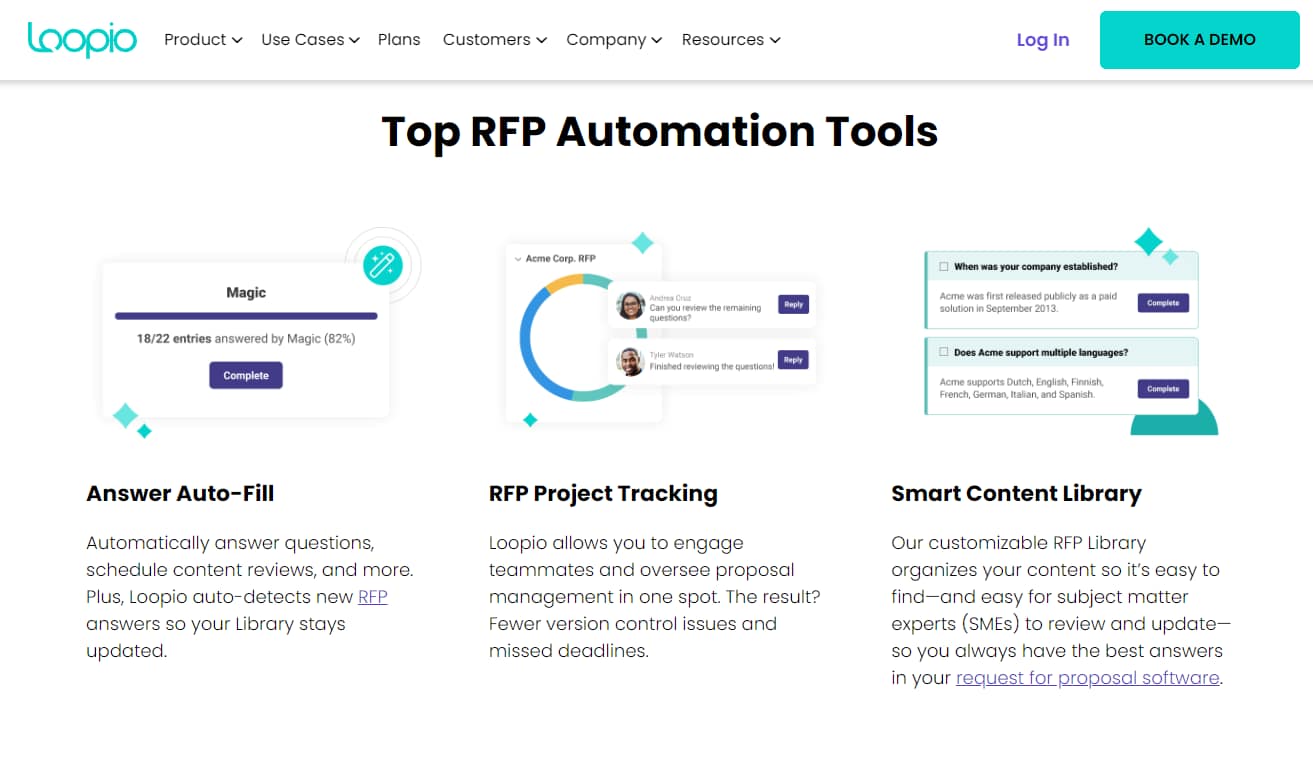
One of the most endorsed tools for RFP management is Loopio. This tool facilitates seamless collaboration among team members, allowing for real-time updates and feedback incorporation.
Loopio’s comprehensive features cater to diverse needs throughout the RFP lifecycle. Its robust document management capabilities let you access essential resources. You can find company overviews and past RFP presentations easily.
Expert Strategies for Software Development Request for Proposal Writing
Let’s now discuss the step-by-step process of writing the proposal. Here are the dos and don’ts of RFP writing.
Tips for Articulating Requirements and Scope

A clear articulation of requirements and scope sets the tone for the success of your software RFP. Here are some valuable tips to effectively communicate this critical information:
- Be Specific and Concrete: Avoid vague descriptions and use precise language. Clearly describe features, functionalities, integrations, and systems that the software must interface with, if any.
- Prioritize Your Requirements: Not all requirements are equally important. Use a tiered system (e.g., must-haves, nice-to-haves) to categorize requirements by priority. This helps vendors understand where there is room for flexibility.
- Provide Context: Explain why specific requirements exist, especially if they are unique to your industry or business. This insight can help vendors tailor their proposals more effectively.
- Use Industry Terminology Wisely: While it’s important to be clear, beware of overusing technical jargon that could confuse vendors who might not be familiar with your specific industry terms.
- Include Use Cases or Scenarios: Illustrating how the software will be used with real-world use cases or scenarios can give vendors a clearer idea of your needs.
- Define Project Boundaries: Outline what the project will involve and what it will not include (known as “out of scope”) to prevent assumptions that could lead to scope creep.
- Ask for Suggestions: Encourage vendors to propose alternative solutions to your requirements. They may offer options you haven’t considered that could provide additional benefits.
Communication is key in the RFP process. Detailing what you need with clarity and precision will lead to more accurate and useful vendor responses, ultimately resulting in a more successful project outcome.
How to Establish Budget and Timeline Parameters in the RFP
When crafting your RFP, establishing clear budget and timeline parameters is paramount. Here is a guide to help you articulate these elements effectively:
- Be Open About Your Budget: While you may not want to disclose the exact budget, providing a range can help vendors understand your financial constraints and tailor their proposals accordingly.
- Justify Your Budget Constraints: Explain the rationale behind your budget range to prevent vendors from making inaccurate assumptions about your financial situation.
- Highlight Payment Structure Preferences: Whether you prefer a fixed-price contract, time-and-materials, or another payment structure, communicating this upfront can impact vendor interest and the structure of their proposals.
- Define Key Milestones: Break down the project into major milestones and assign tentative dates. This sets expectations and allows vendors to align their project management strategies with your timeframe.
- Specify Your Project Deadline: Clearly state the overall project delivery date. Be realistic about your timeframe to ensure quality proposals and achievable outcomes.
- Request Detailed Time Estimates: Ask vendors to provide their timelines for each aspect of the project, along with the rationale for these estimates, to gauge their understanding and feasibility of the project schedule.
- Address Timeline Flexibility: Make it known if there is any flexibility in your project schedule. At the same time, be clear about any hard deadlines due to business cycles, regulatory requirements, or seasonal considerations.
- Discuss Potential Roadblocks: Anticipate potential delays or challenges that might impact the project timeline and ask vendors how they would handle such situations.
By clearly outlining your budgetary expectations and project timeline, you give vendors the information they need to submit a responsive and feasible proposal.
This approach fosters a transparent bidding environment where both parties understand the financial and temporal frameworks of the project.
Common Pitfalls and How to Avoid Them
Some businesses fail to acquire the right vendors because of poorly written RFPs. Here are the common mistakes startups make in creating their RFPs, leading to poor results.
Inadequate Research and Unrealistic Expectations
In drafting a software RFP, it’s essential to confront potential roadblocks that could derail your sourcing efforts.
Among these are inadequate research and unrealistic expectations, which can complicate the procurement process:
- Failing to Understand Market Rates: Proper research into current market rates for technology solutions is crucial. Underestimating costs can lead to unrealistic budget expectations and misconceptions about quote validity, contributing to project pitfalls.
- Overlooking Vendor Expertise: Inadequate research may result in overlooking niche vendors with specific expertise. Knowing the players in the field opens up opportunities for tailored and effective solutions, addressing project functionality and infrastructure requirements.
- Setting Unattainable Deadlines: Unrealistic timelines often stem from a lack of understanding of the time requirements of development processes. Analyzing past projects can provide more realistic time frames and ensure project accuracy.
- Ignoring Integration Needs: Failing to acknowledge the complexity of integrating new software with existing systems is standard. Understanding your current technical environment, including project infrastructure requirements, is crucial for successful integration.
- Misjudging the Complexity of Customization: Assuming extensive customization can be done quickly and cheaply is a misconception. Understanding customization complexities helps set appropriate expectations and ensures adherence to project methodologies.
To avoid these pitfalls, invest time in pre-RFP discovery work.
Gather insights from internal stakeholders, engage with potential users, and consult with technology experts to better understand what is realistic and attainable regarding technology, budget, and timelines.
This due diligence will significantly improve the quality of your RFP and the viability of the proposals you’ll receive.
Ambiguity in Evaluation Criteria and Selection Process
When choosing a vendor for your software project, ambiguity in the evaluation criteria and selection process can lead to confusion and inconsistency. Here’s how to avoid it and establish a clear, objective evaluation framework:
- Provide Detailed Evaluation Metrics: Clearly define how proposals will be assessed. Factors might include cost, alignment with technical requirements, vendor experience and reputation, and proposed timeline.
- Weight Your Criteria: Assign weights to each evaluation metric to reflect their importance to the project. This ensures that critical factors have a corresponding impact on the overall assessment.
- Define the Selection Process: Outline each step, from the initial review to the final decision, including any presentations or demos that vendors must deliver as part of their proposal.
- Establish a Scoring System: Implement a standardized scoring system to quantify the evaluation criteria. This could be a numerical scale or a qualitative measure that can help simplify decision-making.
- Include Stakeholders in the Process: Designate who, within your organization, will be involved in the evaluation and how their input will be collected and weighted. This encompasses technical professionals, end-users, and the finance department.
- Communicate the Timeline for Decision Making: Let vendors know when they can expect a decision. This keeps the process moving and demonstrates respect for the vendors’ time and resources.
- Inform the Criteria for Disqualification: State any grounds on which proposals may be automatically disqualified, such as missing the submission deadline or failing to meet mandatory requirements.
- Maintain Transparency: Aim for an RFP process that is transparent and fair. This builds trust and credibility with potential suppliers, which is the foundation of a good partnership.
By providing a clear and detailed explanation of your evaluation criteria and selection process in your RFP, you will attract higher quality and more targeted proposals. And you can streamline the path toward selecting the best vendor for your project.
Evaluating Responses and Selecting the Right Partner
Once your RFP is ready, you can start evaluating your shortlisted vendors. Here are some tips on making this task more efficient.
Scoring Proposals: Cutting through the Noise
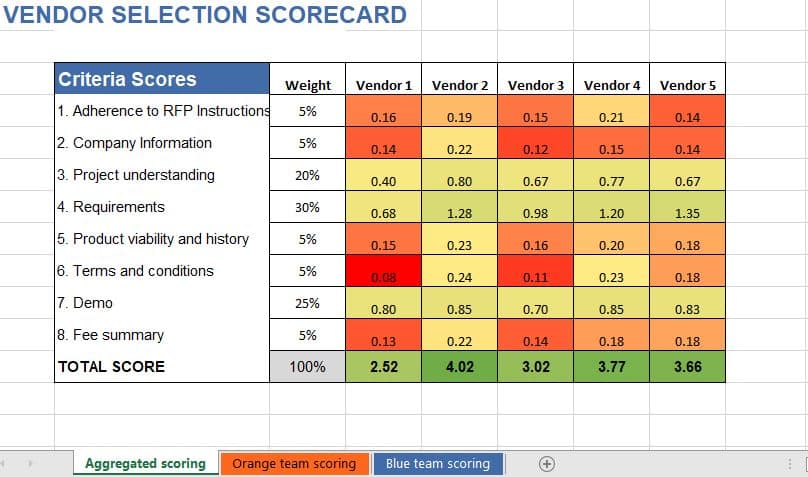
When evaluating and scoring proposals, an effective strategy is key to cutting through the noise and identifying the best vendor for your software project.
Here are some guidelines for an objective and efficient scoring process:
- Develop a Scoring Matrix: Create a detailed scoring matrix that outlines all the criteria you will assess. This matrix should align with the priorities listed in your RFP and can include factors such as project methodology, price, technical capabilities, and company reputation.
- Assign Point Values: For each criterion in your matrix, assign a maximum point value that reflects its importance to the project’s success. Weight the scores so that essential elements have a proportionately more significant impact on the total score.
- Create a Review Committee: Assemble a panel of internal stakeholders to review and score the proposals. This should include individuals with a mix of expertise, including technical experts, project managers, financial analysts, and end-users.
- Ensure Consistent Application: Make sure every reviewer is on the same page regarding how to interpret the scoring criteria. This may involve a briefing or training session on the scoring matrix before evaluations begin.
- Score Independently and Discuss Collectively: All review committee members should initially score proposals independently to prevent groupthink or undue influence. Afterward, convene as a group to discuss the scores and obtain a comprehensive view.
- Look for Red Flags: Be vigilant for discrepancies or areas where a vendor may have glossed over specifics. Unusually high or low bids or vague responses to detailed requirements should be carefully examined and discussed.
- Include Qualitative Assessments: Beyond numerical scoring, include qualitative assessments, like vendor interviews or demonstrations. This can provide additional insights into a vendor’s approach and compatibility with your organization.
Adhering to an established, transparent scoring process ensures a fair evaluation of all proposals.
This helps to eliminate bias and highlights the vendors who truly understand and align with your project objectives and organizational needs.
Making the Final Decision: Key Considerations for Awarding the Contract
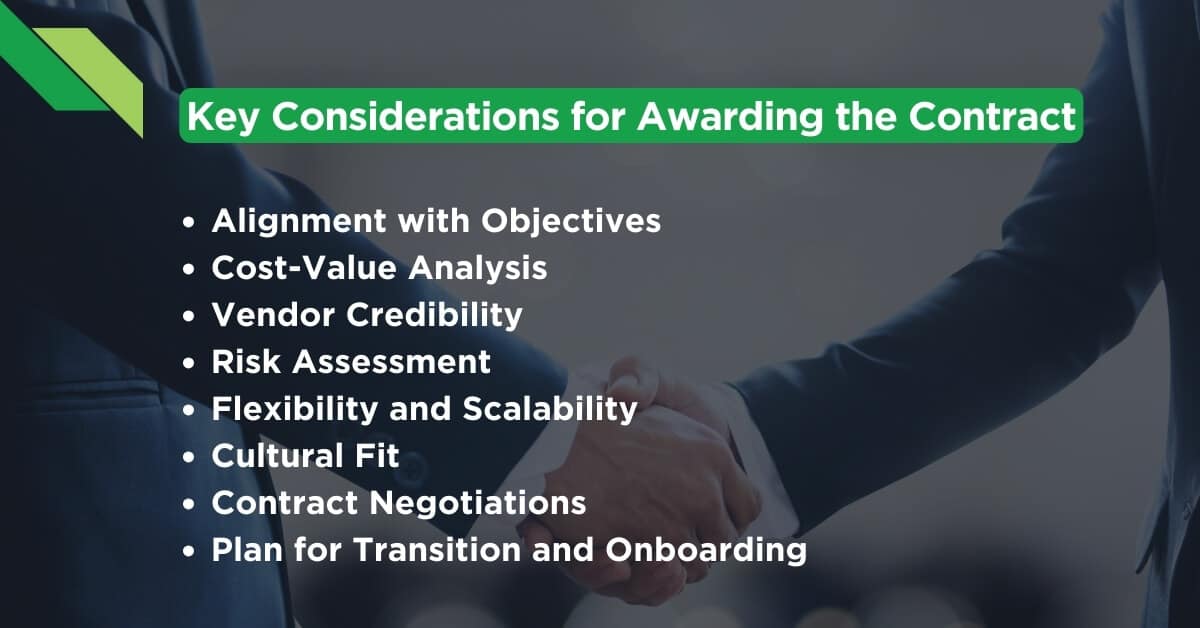
As you approach the final decision on which vendor to select for your software project, several key considerations should guide your awarding of the contract:
- Alignment with Objectives: Ensure the chosen vendor’s proposal aligns closely with the project goals and objectives outlined in your RFP. The best fit will have demonstrated a thorough understanding of what you’re trying to achieve and offered a clear path to realization.
- Cost-Value Analysis: Cost is a significant factor, but it shouldn’t be the sole criterion. Evaluate the value each proposal offers. A higher-priced bid may be justifiable if it provides a better return on investment through improved efficiencies, greater innovation, or a more robust set of features.
- Vendor Credibility: Research the vendor’s reputation, stability, and track record of delivering on time and within budget. Check references and reviews to ensure previous clients have had positive experiences.
- Risk Assessment: Assess the potential risks associated with each proposal, including technical feasibility, the vendor’s capacity to handle unforeseen issues, and the solution’s scalability.
- Flexibility and Scalability: The chosen vendor should be adaptable to changes and growth within your organization. Their solution should be scalable to accommodate expanding needs without requiring a full overhaul.
- Cultural Fit: The working relationship with the vendor is crucial to the project’s success. Factors such as communication style, shared values, and compatibility should not be underestimated.
- Contract Negotiations: Be prepared to enter negotiations with the chosen vendor to refine terms and conditions. This includes clear definitions of deliverables, timelines, payment schedules, and provisions for change management.
- Plan for Transition and Onboarding: Consider how the vendor handles the transition from project kickoff to completion and subsequent support. This can influence the overall success and adoption of the new software.
Remember to document the rationale behind your decision thoroughly. This not only provides transparency but also serves as helpful information for all stakeholders involved and for future projects.
When the decision has been made, notify the chosen vendor and communicate with those not selected, providing feedback where appropriate. This fosters good relations and can help unsuccessful bidders improve for future RFPs.
Choose A Solid Offshore Development Partner
The value of RFP for software development is undeniable in today’s competitive environment. It has become a tool for identifying and establishing partnerships.
However, there are also a lot of risks involved in the process. This is why you’ll need a reliable partner to help you complete your project. And this is where Full Scale comes in.
Full Scale is an IT outsourcing company that helps businesses grow their team. We’ll help you build software from scratch and transform it into a high-quality asset.
With our expertise, commitment to quality, and tailored solutions, we turn your vision into reality.
Get in touch with us today to start building something exceptional together!
Work With A Professional Company

Matt Watson is a serial tech entrepreneur who has started four companies and had a nine-figure exit. He was the founder and CTO of VinSolutions, the #1 CRM software used in today’s automotive industry. He has over twenty years of experience working as a tech CTO and building cutting-edge SaaS solutions.
As the CEO of Full Scale, he has helped over 100 tech companies build their software services and development teams. Full Scale specializes in helping tech companies grow by augmenting their in-house teams with software development talent from the Philippines.
Matt hosts Startup Hustle, a top podcast about entrepreneurship with over 6 million downloads. He has a wealth of knowledge about startups and business from his personal experience and from interviewing hundreds of other entrepreneurs.




